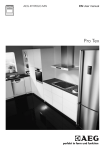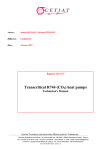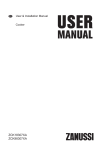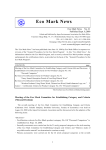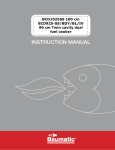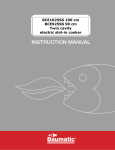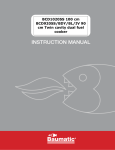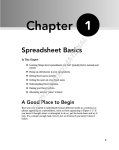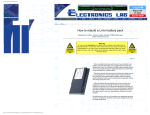Download EURO EGT6S8MS Technical information
Transcript
INSTALLATION AND OPERATION MANUAL BUILT-IN ELECTRIC OVENS MODEL: EPT600S8X EGT8M6SX EGT6S8MS 461308134_000 06/2012 Dear Owner, Congratulations on the purchase of your new appliance. Now that you have your new built-in gas oven, please take the time to do a couple of very simple tasks. Firstly, read the user instructions contained in the first section of this booklet. Your new appliance has been designed and manufactured to the highest standards and incorporates a host of innovative styling and technical features. The time invested in studying this booklet will familiarize you with these features and help you to achieve the best results and get the most enjoyment from your appliance. It could also spare you the inconvenience of any unnecessary service faults. We wish you many years of cooking pleasure from your built-in gas oven. This booklet will serve as a valuable reference guide and is best retained in a safe place. The manufacturer shall not be held responsible for any damage to persons or property caused by incorrect installation or use of the appliance. A duplicate data label and wiring diagram are contained in this booklet. Please attach these labels to an accessible surface near by the appliance for easy reference. The manufacturer will not be held responsible for any inaccuracies in this handbook due to printing or transcription errors. Diagrams and figures are purely indicative, strict accuracy is not guaranteed. The manufacturer also reserves the right to make any modifications to the products as may be considered necessary or useful, or also in the interests of the users, without jeopardizing the main functional and safety features of the product themselves. The appliance was designed and made in accordance with the International standards listed below: =>IEC 60 335-1 and IEC 60 335-2-6 (electrical) plus relative amendments The appliance complies with the prescriptions of the International Directives as below: Electrical safety (BT). Electromagnetic compatibility (EMC) Gas safety. CONTENTS IMPORTANT NOTES AND PRECAUTIONS 3 DESCRIPTION OF THE APPLIANCE 4-7 INSTRUCTIONS FOR THE USER 8-13 TROUBLESHOOTING 13 TECHNICAL FEATURES 14 INSTRUCTIONS FOR THE INSTALLER 14-16 2 IMPORTANT NOTES AND PRECAUTIONS This new appliance is easy to use but before installing and using it is important to read this handbook through carefully. It provides information for a safe installation, use and maintenance. Keep this handbook in a safe place for future reference. N.B.: the pictures shown in the figures in this handbook are purely indicative. • The installation, adjustments, conversions and maintenance operations listed in section «INSTRUCTIONS FOR THE INSTALLER» must only be carried out by authorised personnel . . Prior to connecting the appliance ensure that the rating plate data correspond to those of the gas and electricity mains (see part «5. TECHNICAL FEATURES»). • Once the outer wrapping and the inner wrappings of the various parts have been removed, check and make sure that the appliance is in perfect condition. If you have any doubts do not use the appliance and call in a qualified person. • The packaging materials used (cardboard, bags, polystyrene foam, nails, etc.) must not be left anywhere in easy reach of children because they are a potential hazard source. To safeguard the environment all packaging materials are environment friendly and recyclable. • The electrical safety of this appliance is only guaranteed if it is correctly connected to a suitable earth system, as prescribed by the electrical safety standards. The manufacturer disclaims all responsibility if these instructions are not followed. Should you have any doubts, seek the assistance of an authorised person. • The appliance must only be used for its original purpose, that is, cooking for domestic use. Any other use is considered improper and, as such, dangerous. The manufacturer cannot be held responsible for any damage to persons or property resulting from an incorrect use of the appliance. • Do not spray aerosols in the cavity of this appliance while it is in operation. • Do not use or store flammable materials near this appliance. Do not modify this appliance • Do not install this appliance on a marine craft or in a caravan or do not use this appliance as a space heater. There are a few basic rules that must be observed when using the appliance: => Do not touch any electrical appliance if hands or feet are wet or damp. => Do not use the appliance bare footed. => Do not pull the power lead to take the plug out of the socket. => Do not leave the appliance outside under the sun, rain, etc. • This appliance is not intended for use by persons (including children) with reduced physical, sensory or mental capabilities, or lack of experience and knowledge, unless they have been given supervision or instruction concerning use of the appliance by a person responsible for their safety. • Children must be supervised to make sure that they do not play with the appliance • Before cooking for the first time, ensure the oven is empty and its door closed, heat the oven at maximum temperature for two hours. This will allow the protective coating on the interior of the oven to be burnt off and dissipate the associated smells. Ensure adequate ventilation in the kitchen whilst burning off and don’t be alarmed by a little bit of smoke during this process. • When lighting the oven compartment burners the oven door must always be kept open and if after approximately 15 seconds, the burners fail to light, release the knob and wait at least 1 minute before trying again. Should the burner turn out accidentally, turn the knob round to the closed position and wait at least 1 minute before lighting it again. • Always keep the oven door closed during baking. It must only be left ajar when using the gas grill burner (see relative instructions). • ATTENTION!!! During and after use the glass of the oven door and accessible parts may be very hot so it is essential that young children be kept away from the cooker. • To open the oven door always grip the centre of it. • Do not worry if condensation forms on the door and on the inside walls of the oven during use. This does not influence how it works. When you open the oven door, mind the boiling steam that escapes. • When putting food in or taking it out of the oven make sure the condiments do not drip copiously on the bottom (overheated oils and fats easily ignite). • During baking, to avoid bad results, do not cover the bottom of the oven or the shelves with sheets of tin foil or other material. Never cover the grill tray or grid with cooking foil as this creates a fire hazard. • Keep the appliance clean. Food deposits could be a fire risk. • Avoid using the oven as a larder or as a saucepan cupboard when you are not using it for cooking: if the oven is turned on accidentally it could cause damage and accidents. • Do not place flammable materials inside warming drawer. • If you are using an electrical socket near the appliance, make sure that the cables are not touching the oven and are far enough away from all hot parts. • When you have finished using the appliance check that all the controls are in the off or closed position, checking that the “0” of the knob corresponds to the “•” symbol serigraphed on the front panel. • In the case of a failure or malfunction, turn the oven off and switch off the electrical supply; do not tamper with it. All repairs or settings must be carried out with maximum care and the proper attention of a qualified person. For this reason we recommend you contact the nearest Service, to report the problem explaining the trouble and giving the name of the model. • If an appliance is out of order or is not going to be used any more it must be rendered safe by eliminating those parts that could be a source of hazard to children when playing, for example: the power cable, any systems for locking the oven door and spits. 3 DESCRIPTION OF THE APPLIANCE GENERAL DESCRIPTION To prevent the oven from overheating it has been equipped with a safety temperature device, which automatically turns on in case the main thermostat fails to work. In such an event, the electricity is temporarily cut off: do not try to fix the failure yourself, instead turn the appliance off and report to your local Dealer or Service Centre. The appliance is fitted with a cooling fan to cool the front control panel, the knobs, the oven door handle and the electrical components. The cooling fan turns on automatically when you switch on the oven and turns off when the appliance has switched off; The oven may be equipped with guide bars, either fixed (fig. 1) which allow for housing a number of accessories, the type and the quantity of which may vary depending on the model: • Oven shelf • Drip pan + trivet+ grill pan handle • Pastry or pizza oven tray � � � � � � �� � 1 2 4 DESCRIPTION OF THE APPLIANCE CONTROLS a THERMOSTAT KNOB (A) Turning the oven knob clockwise selects and sets the oven baking temperature (50°C to maximum heat). EIGHT FUNCTIONS SELECTOR KNOB (B) Turning the oven knob either clockwise or anticlockwise, the following function symbols are available: 0 ��� �� �� ��� ��� ��� ��� ��� ��� = Oven off = Oven lights on (stays lit with all functions) = Fan on B � = Top and bottom heating elements on = Top and bottom heating elements on plus fan = Bottom heating element on plus fan = Rear heating element on plus fan = Grill = Grill heating element on plus fan YELLOW WARNING LIGHT When lit it indicates that either the electric oven or electric grill is working. While the oven is being used the light will switch off when the set temperature is reached. During baking it is normal for the yellow light to switch on and off several times as the oven temperature is controlled. TIMER WITH COOKING TIME (C) This accessory has a dual function: it signals how much cooking time has elapsed and it also turns the oven off automatically. N.B.: When the pointer of the knob is on «•» position, the oven cannot work. If you use the oven without any programming, check that the timer is on the manual position. Semi-automatic operation After having selected a cooking, to set cooking time, first wind the timer up by turning it completely once from left to right and then back to the number of minutes you want, from 0 to 120 minutes: the oven will switch on. Once the programmed time has elapsed the buzzer will ring and the end of cooking time device triggers. �� C � �� Manual operation It the cooking time is more than 2 hours, or if you want to use the oven without the timer, turn knob from right to left until the pointer is on the symbol. When the food is cooked do not forget to move the knob pointer round to position «•». ��� �� ��� �� ��� �� �� 5 �� �� �� DESCRIPTION OF THE APPLIANCE ELECTRONIC PROGRAMMER This accessory operates the following features: - Clock (set by keys 2 and 3) - Timer (set by key 1) - Cooking time (set by key 2) - End of cooking time (set by key 3) - Manual operation settings (set by keys 2 and 3) - Setting time backwards (set by key 4) - Setting time forward (set by key 5) Semi-automatic working order (setting end of cooking from 0,01 to 23,59 = hh,mm) Press key 3 and set the end of your cooking session by key 5; both symbols “A” and turn on. Once the set hour is reached, turns off, “A” flashes and the buzzer rings. Automatic operation (with a delayed start) Set the cooking period first ( “A” and turn on) then set the end of cooking time ( turns off) as previously described. Symbol turns on again when at the start of cooking session. When cooking time is over, turns off, “A” flashes and the buzzer will advice cooking completion. The digital display always shows the time and can be set to show cooking time or end of cooking count-down simply by pressing the corresponding key. Please Note: When the cooking session is over the programme automatically turns off the oven (except for the timer). Should you wish to proceed manually next time you use the oven, make sure you set the manual operation function (see instructions further on). Buzzer The buzzer starts ringing when a cooking session has reached its completion or the timer countdown is over. It can ring up to 7 minutes. Press any function key to make it stop beforehand. Programme start and control The programme starts immediately after setting. To check settings of the programme press the corresponding key. Time setting ( 0:01 to 24:00 = hh,mm) When plugging in the appliance the first time or subsequent a power cut, the display shows both “A” and “0.00” (or the minutes past the power failure) signs flashing. To reset the time push keys 2 and 3 simultaneously then press key 4 or 5 till you reach the exact current time. When done, the “A” symbol turns off and the manual operation symbol is lit. Modify or Cancel programme setting In case the current time displayed on the clock is within the cooking period set, an error in the automatic function occurs, and both the buzzer ring and the flashing «A» draw your attention. Such error in the set up can be amended by varying the cooking time length or its end. Any programme set can be modified at any time by pressing first its corresponding programme key and then key 4 or 5. To cancel a programme, correct the time set bringing it to a value of “0.00”. When functioning time is cancelled the end of functioning is cancelled too and vice versa. The oven turns off automatically and the “A” symbol flashes. Manual operation Each time the time is set, the programme sets automatically on manual working order. The only other case when this occurs is when an automatic programme reaches completion, or has been cancelled by pressing keys 2 and 3 at the same time. The “A” symbol disappears and the turns on. Timer setting ( 0:01 to 0:59 = hh,mm) Press key 1 and select cooking time by pushing key 4 or 5. Symbol turns on. Once the time set is expired the acoustic alarm rings and turns off. Semi-automatic working order (cooking period from 0:01 to 23:59 = hh,mm) Press key 2 and set cooking time by keys 4 or 5; both symbols “A” and are lit. Once the set period is over, turns off, “A” flashes and the buzzer rings. � � � � � 6 INSTRUCTIONS FOR THE USER GENERAL NOTES ON SAFETY HOW TO USE THE MULTIFUNCTION OVEN • Never leave the oven unsupervised when cooking. Make sure that children do not play with the appliance. • To open the oven door, grab the door handle at its middle. Avoid forcing the oven door when it is open. • Do not worry if steam condensation accumulates on the door and on the inside walls of the oven during use. This does not affect its working order. • Mind hot steam when opening the oven door. • The appliance becomes very hot during use. Do not touch the heating elements inside the oven. Wear oven gloves when placing or removing pans from the oven. • When removing the tray from the oven, always use the handle (D) (fig. 4) (if provided). Hook the handle to the edge of the tray and pull it out, slightly lifting it as you do so. • In placing foods into or removing them from the oven, make sure sauces do not drip onto the hot plate of the oven (overheated oils and fats can easily ignite). • Use only ovenware resistant to the temperature range indicated on the thermostat knob. • During baking, avoid covering the bottom plate of the oven or its grid with tin foil or other material. Saucepans, oven trays and all other ovenware must always be placed on the oven grid. • After use of the appliance, make sure that all the controls are set to the off or closed positions. • IMPORTANT WARNING: During and after use the oven crystal door and all surfaces may be very hot. Keep children away from the oven! DEFROSTING AT ROOM TEMPERATURE Turn the selector knob to the symbol and place the food you want to defrost inside the oven. The length of time required depends on the quantity and type of food. Selecting this function will only activate the fan. Mild air circulation around frozen food will slowly defrost it. It is particularly suitable for fruit and cakes. TRADITIONAL COOKING Turn the selector knob to the symbol and adjust the thermostat knob to the desired temperature. If pre-heating is recommended wait till the thermostat yellow warning light turns off before placing foods inside the oven. This option turns on both bottom and top heating units, evenly distributing heat on your foods. This type of cooking is ideal for all kind of foods (meats, fish, bread, pizzas, cakes..). COMBINED TRADITIONAL + FAN COOKING Turn the selector knob to the symbol and adjust the thermostat knob to the desired temperature. If pre-heating is recommended wait till the thermostat yellow warning light turns off before placing foods inside the oven. This option turns on both bottom and top heating units, and heat is distributed by fan ventilation. This combination is suitable for rapid cooking and allows for the use of more plates positioned on the different levels of the oven. DEFROSTING + WARM UP BY HOT AIR Turn the selector knob to the symbol and adjust the thermostat knob to the desired temperature, then place the food inside the oven. Selecting this function will activate the bottom heating unit and its heat is distributed by the fan. This function is particularly recommended to defrost and warm up ready-made meals. IMPORTANT!! The oven door must stay closed when using both the oven and the grill. WHAT TO DO THE FIRST TIME YOU USE THE OVEN If the appliance has a programming accessory, place it on the manual position, and, before cooking for the first time, ensure the oven is empty and its door closed, heat the oven at maximum temperature for 2 hours. This will allow the protective coating on the interior of the oven to be burnt off and dissipate the associated smells. During this time do not stay in the same room and keep it aerated. After the hour or so has elapsed leave the oven to cool down and then clean its interior with hot water and a mild detergent. Also wash the accessories (shelves, trays, drip pan, spit..) prior to use. FAN FORCED COOKING Turn the selector knob to the symbol and adjust the thermostat knob to the desired temperature, then place your food inside the oven. If pre-heating is recommended wait till the thermostat yellow warning light turns off before placing foods inside oven. This function activates the rear heating unit and the fan distributes the heat produced. This combination allows for a fast and even cooking of several different foods placed on the diverse levels of the oven (fig.3). Prior to any cleaning, disconnect the appliance from the electricity mains. 7 INSTRUCTIONS FOR THE USER CONVETIONAL GRILL COOKING Turn the selector knob to the symbol and adjust the thermostat knob to the desired temperature. Selecting this function the top central heating element turns on and heat is distributed directly on food surface. Apart from grilling, this function is ideal to add a golden roast to your recipes or to toast bread slices. The grill function automatically activates the spit. When you use the grill, do not forget to place the drip pan beneath it to collect any sauce dripping, as suggested in the “USEFUL COOKING TIPS“ section. FAN GRILL COOKING Turn the selector knob to the symbol and adjust the thermostat knob to the desired temperature. Selecting this function the top central heating element turns on and heat is distributed by the fan. This procedure mitigates the direct heat on food surface and uses milder temperatures. It is therefore recommended for an even golden and crispy finish touch, ideal for whole fish and poultry. When you use the grill, do not forget to place the drip pan beneath it to collect any sauce dripping, as suggested in the “USEFUL COOKING TIPS“ section. 3 4 8 INSTRUCTIONS FOR THE USER USEFUL COOKING TIPS Meat: • If, when cooking meat, the time needed is more than 40 minutes, turn the oven off 10 minutes before the end of cooking time to exploit the residual heat (energy saving). • Your roast will be juicier if cooked in a closed pan; it will be crispier if cooked without a lid. • Normally white meat, poultry and fish need medium temperatures (less than 200°C). • To cook “rare” red meats, high temperatures (over 200°C) and short cooking times are needed. • For a tasty roast, lard and spice the meat. • If your roast is tough: the next time leave the meat to ripen longer. • If your roast is too dark on top or underneath: the next time put it on a higher or lower shelf, lower the temperature and cook longer. • Your roast is underdone? Cut it in slices, arrange the slices on a baking tray with the gravy and finish cooking it. Cakes and bread: • Heat the oven for at least 15 minutes before you start cooking bread or cakes. • Do not open the door during baking because the cold air would stop the yeast from rising. • When the cake is cooked turn the oven off and leave it in for about 10 minutes. • Do not use the enamelled oven tray or drip pan, supplied with the oven, to cook cakes in. • How do you know when the cake is cooked? About 5 minutes before the end of cooking time, put a cake tester or skewer in the highest part of the cake. If it comes out clean the cake is cooked. • And if the cake sinks? The next time use less liquids or lower the temperature 10°C. • If the cake is too dry: Make some tiny holes with a toothpick and pour some drops of fruit juice or spirits on it. The next time, increase the temperature 10°C and set a shorter cooking time. • If the cake is too dark on top: the next time put the cake on a lower shelf, cook it at a lower temperature and longer. • If the top of the cake is burnt: cut off the burnt layer and cover with sugar or decorate it with cream, jam, confectioner’s cream, etc.. • If the cake is too dark underneath: the next time place it on a higher shelf and cook it at a lower temperature. • If the cake or bread is cooked nicely outside but is still uncooked inside: the next time use less liquids, cook at a lower temperature and longer. • If the cake will not come out of the tin: slide a knife around the edges, place a damp cloth over the cake and turn the tin upside down. The next time grease the tin well and sprinkle it with flour or bread crumbs. • If the biscuits will not come away from the baking tray: put the tray back in the oven for a while and lift the biscuits up before they cool. The next time use a sheet of baking parchment to prevent this happening again. Grilling: • Sparingly grease and flavour the food before grilling it. • Always use the drip pan to catch any dripping from the meat during grilling (fig. 4 - if provided) or slide it in one of the levels underneath the grill or place it at the bottom of the oven. Always pour a little water in the drip pan. It will prevent grease and sauces from burning avoiding burnt smells and smoke. Add more water during cooking to compensate for evaporation. • Turn the food upside-down when half way through cooking. The aluminium can be easily corroded if it comes into contact with organic acids present in the foods or added during baking (vinegar, lemon juice). Therefore it is advised not to put directly the foods on aluminium or enamelled trays, but ALWAYS use the proper oven paper. 9 INSTRUCTIONS FOR THE USER COOKING / BAKING TIMETABLE FOODS MEAT LOAFS Roasted Veal Roasted Pork Roastbeef Roasted Lamb POULTRY Roasted Chicken Roasted Turkey Roasted Duckling FISH Roasted whole fish Sea bass PIZZA BREAD PATISSERY Biscuits / Cookies Biscuits Coconut biscuits Lemon biscuits Muffins Sweet “bun” rolls Sweet “bun” rolls CAKES/FLANS Angel Cake/Sponge Apple flan Fruit jam tart/flan Fruit jam tart/flan Strudel Quiche kg Pan or Baking tray Position of the oven shelf from the bottom 1 1 1.15 2 Weight TRADITIONAL OVEN FAN OVEN 4 guide bars Temperature in °C Cooking/Baking Time (in minutes) 1 1 1 1 2 2 1 or 2 1 or 2 200-220 200-220 220 230 100-90 120-100 60 165 200-220 200-220 = = 100-90 120-100 = = 1 6 1.5 1 1 1 2 2 2 200-220 220 = 100-90 150 = = = 200-220 = = 150-120 1 0.6 1.15 1 1x2 1 1 1 1 1 2 1 2 1 or 2 1 or 2 2 1 and 3 2 200 220 220 225-Max = 200-220 30-35 30 45 25-30 = 27-20 = = = 220 200-220 = = = = 20 25-35 = 1 2 2 2 2 1 2 2 1 and 3 1 and 3 1 and 3 1 and 3 2 1 and 3 180 = = = 180 225 = 20-25 = = = 30-35 18 = 190 170-190 170-190 170-190 160-170 = 200 15 18-15 25-20 27-23 30-25 = 16 1 1 1 2 2 or 3 2 or 3 2 2 2 1 and 3 1 1 190 190 = = 180-190 = 52 60 = = 60-50 = 190 = 190 175-190 = 200-210 45 = 45 50-40 = 55-45 0.8 = = = = = Temperature Cooking/Baking in °C Time (in minutes) Values indicated in the tables (temperatures and cooking times) are approximate and may vary according to each person’s cooking habits. GRILLING TIMETABLE FOODS MEAT T-bone steak Steak Chicken (cut in half ) FISH Trout Sea bass Sole Weight kg Nr. of pieces Position of the oven shelf from the bottom 4 guide bars TRADITIONAL OVEN Temperature in °C fan OVEN Cooking/Baking Time (in minutes) 1st side 2nd side Temperature in °C Cooking/Baking Time (in minutes) 1st side 2nd side 0,50 0,15 1 2 1 or 2 4 4 3 or 4 225-Max 200-225 225 12-15 5 20 12-15 5 20 200 = = 15 = = 10 = = 0,50 0,15 1 2 1 2 4 4 4 = = = = = = = = = 200 200 200 10 10-12 8-9 10 10-12 8-9 Values indicated in the tables (temperatures and cooking times) are approximate and may vary according to each person’s cooking habits. More specifically, when grilling meat cuts the values are subject to the thickness of the slice or loaf and to personal taste as well. 10 INSTRUCTIONS 3. ISTRUZIONI PER FORL’UTENTE THE USER CLEANING AND MAINTENANCE INTERIOR PARTS The oven cavity should be cleaned after each use to remove cooking residuals and or grease or sugar which, if burnt on when the oven is used again, will form deposits or unremovable stains as well as unpleasant smells. To maintain the shine of the enamelled parts, clean them with warm soapy water, rinse and dry them thoroughly. ALWAYS wash the accessories used. Do not spray or wash the electric heating elements or the thermostat bulb with acid-based detergents (check the information label on the product you are using). The manufacturer cannot be held responsible for any damages caused by incorrect cleaning. • Prior to any maintenance work or cleaning, disconnect the appliance from the electricity mains. • Do not use a steam cleaner to clean a hob, oven or range. • Do not wash the parts if they are still hot. • Do not use metal pads, abrasive powders or corrosive spray products for cleaning • Do not leave vinegar, coffee, milk, salty water or the juice of lemon or tomato on enamelled surfaces for any length of time. Switch off the oven before removing the fan guard for cleaning. Replace the guard after cleaning OVEN SEAL The condition of the oven seal is vital for the correct functioning and performance of the oven. We recommend you: • Clean it, avoiding abrasive tools or products. • Check its condition occasionally. EXTERIOR PARTS All the parts of the oven exterior (stainless steel, side panels, door glass) must be cleaned frequently with a mild detergent and a little water and then dried with a soft cloth. Do not use harsh abrasive cleaners or sharp metal scrapers to clean the oven glass door since they can scratch the surface, which may result in shattering of the glass. Never use sponges or abrasive products, and aromatic or aliphatic solvents to remove stains or adhesives on the painted or stainless steel surfaces. In case the seal has stiffened or presents damages, contact your nearest Service centre and avoid using the oven until it has been repaired. INTERNAL OVEN DOOR GLASS One of the features of our ovens is that the internal oven door glass can be easily removed for cleaning without the aid of specialized personnel. Just open the oven door and extract the support to which is attached the glass (fig. 5 or 6). ATTENTION!! This operation can also be carried out while the door is assembled on the appliance, however in this case, with the door horizontally hinged take the utmost care when extracting the glass upwards, the force of the hinges can suddenly snap the door shut. 5 6 11 INSTRUCTIONS 3. ISTRUZIONI PER FORL’UTENTE THE USER OVEN SIDEWALL GRIDS (fig. 7) To allow for a better cleaning of the side grids, you can extract them this way: • Push with a finger on the last of the slots to release the grid from its hold (A). • Lift it towards the top and extract the grid. To put them back into place, reverse the order of this operation. 7 � � REPLACING THE OVEN LAMP (fig.8) Attention!! Before replacing the oven light, disconnect the appliance from the electricity supplies. In the event one or both oven lamps need replacing, the new lamps must comply with the following requisites: 15 W - 220 V~ - 50 Hz - E 14 - and must be resistant to high temperature (300°C). Follow the instructions: Extract the side grids as indicated in the previous paragraph. Then, remove glass protection cap (V) from bulb holder by lifting it with a screwdriver (C) against the inside wall of the oven. Substitute the bulb and reposition all elements back by following the operation in reverse order. 8 � � TROUBLESHOOTING PROBLEM occurring SOLUTION envisaged The oven does not work • Check that the plug is connected. • Check that the programmer / clock is set for manual operation. • Check the electrical system (fuse electricity board). If there is failure in the system call an electrician. During cooking the thermostat led does not turn back on • Turn the thermostat round to a hotter temperature. • Turn the selector round to a different function. The oven light does not switch on • Turn the selector round to a different function • Check that the oven bulb is properly fitted • If it has blown, buy a bulb specifically for high temperatures at a Service Centre and fit it following the instructions given on «REPLACING THE OVEN LAMP « paragraph In case the appliance fails to operate correctly, contact our Service Centre. Warning: Servicing should be carried out only by authorised personnel. 12 TECHNICAL FEATURES MINIMUM DIMENSIONS OF THE UNIT TO HOUSE THE OVEN (fig. 9) Height /m Width /mm Depth /mm Volume /dm3 570 560 550 50 ELECTRICAL COMPONENTS Description Lower heating element Top/grill heating element Rear heating element Oven lamp Tangential or cooling fan Fan motor Supply cable Nominal data 170+800 W 800+1800 W 2000 W 15 W - E 14 - T 300 18..22 W 25..29 W H05 RR-F 3x 1.5 mm2 ��� �� ��� � ��� ��� ��� � ��� ��� ��� ��� ��� 9 13 INSTRUCTION FOR THE INSTALLER TECHNICAL INFORMATION WARNINGS • As this is a built-in oven, please ascertain that the walls or panels surrounding the appliance can withstand a temperature of over 95°C. • Also make sure that the glue that joins the laminated plastic coat to the unit can withstand a temperature of around 150°C, to avoid the laminated coat to unglue. All instructions related to installation and maintenance operations listed in this section must be carried out only by authorised personnel. The manufacturer cannot be held responsible for any damage to persons or property resulting from an incorrect installation of the appliance. INSTALLING AND FIXING THE OVEN The oven can be housed into a cabinet or into a base module, making room for its volumes as shown in fig. 9. To guarantee proper aeration of the heat remove the rear panel of the base module or make an escape opening (A), as shown in fig. 9. UNPACKING YOUR APPLIANCE • Once the packaging has been removed, thoroughly check that the appliance is in perfect condition. If you have any doubts do not use the appliance and call our Service Centre. • Do not move the appliance by the handles. • Some parts mounted on the appliance are protected by a plastic film. This protection must be removed before using the appliance. We recommend slitting the plastic film along the edges with a sharp knife or pin. Fixing ovens with door horizontally hinged • Fit the appliance in place. • Open the oven door and secure the oven with the screws supplied (V) (fig. 17). Fixing ovens with door vertically hinged • With the oven door closed, unscrew the inferior screw (fig.17a) with a hexagonal key n. 8 (not supplied) and remove the door take off it from the superior pivot. • Fit the appliance in place and secure it with the screws supplied (V) (fig. 17). • Reassemble the door inserting it in the superior pivot and then, with the door closed, tighten the inferior screw. All packaging materials used (cardboard boxes, bags, polystyrene foam, nails, etc.) must be kept out of the reach of children, as they are a potential hazard source. All packaging materials used are environmentally-friendly and recyclable (wooden bits are free from chemicals, cardboard is 80-100% recycled, protective bags are made in polyethylene (PE), bands in polypropylene (PP) and padding in polystyrene foam (PS) without chlorofluoro-carbides. Waste materials can undergo treatment and be recycled saving on new raw materials and on the amount wasted volumes. For this purpose we suggest you take the packaging material back to the shop you bought the appliance or to a collecting service. Ask your local service for the nearest service. The oven must stand on a solid platform that will withstand its full weight, as screws are only used to secure the appliance inside its cabinet housing. 11 10 � � 14 INSTRUCTION FOR THE INSTALLER ELECTRICAL CONNECTION MAINTENANCE Electrical connection must be carried out in accordance with current standards and normative. Before replacing any spare parts it is vital to disconnect the appliance from the electricity mains. Before connecting the oven check out the following list: • The system and electrical sockets amperage is adequate for the appliance maximum power (see data label affixed on the back of the oven and in the appliance handbook) • The socket or system has an effective earth connection in accordance with current standards and prescriptions of the law. All responsibility is disclaimed if this is not complied with. • The plug and socket or the multipolar switch must be accessible after installation of the appliance. When connecting to the mains with a socket: • Fit a standard plug, suitable for the load, which is indicated on the rating plate, to the power cable. Connect the wires making sure they match the indications below. Pay attention to the earth wire, which must be longer than the phase wires: letter = brown wire L (phase) REPLACING ELECTRICAL COMPONENTS • To replace the oven lamp please refer to instructions on «REPLACING THE OVEN LAMP» paragraph. • To access other electrical components the oven will have to be removed from its housing unit («INSTALLING AND FIXING THE OVEN» section). Oven extraction allows access to the terminal board (T)(fig. 18). • If the power cable needs replacing always keep the earth wire longer than the phase wires and do follow all instructions given in the “ELECTRICAL CONNECTION” section. • Remove the rear protection panel (Q) to have access to the gear motor, heating elements and temperature limiting device (fig. 12). • To change lamp holder (P), remove the superior protection (A) and the side panel, then use a screwdriver to push the two locking tabs (fig. 13) and remove the lamp holder from the inside of the oven. • To replace the thermostat, the commutator, the programmer and the indicator lights, remove protection box (S) (fig. 12). Remove the knobs and undo the screws underneath to free the components that need replacing. letter symbol N (neutral) (earth) = blue wire = green/yellow wire • The power cable must be laid far from heat sources and its temperature should stay below 75°C. • Avoid using adapters or shunts as they could cause false contacts resulting in hazardous overheating. When connecting directly to the mains: • Install a multipolar switch that can withstand the appliance’s load, with a minimum opening between the contacts of 3 mm. Remember that the earth wire must not be cut out by the switch. � � 12 13 � � � � 15 SPACE FOR DATA LABEL 461308134_000 06/2012
















